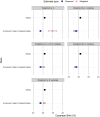Inequalities in cesarean births between American Indian & Alaska Native people and White people
- PMID: 36573019
- PMCID: PMC10012218
- DOI: 10.1111/1475-6773.14122
Inequalities in cesarean births between American Indian & Alaska Native people and White people
Abstract
Objective: To explore population-level American Indian & Alaska Native-White inequalities in cesarean birth incidence after accounting for differences in cesarean indication, age, and other individual-level risk factors.
Data sources and study setting: We used birth certificate data inclusive of all live births within the United States between January 1 and December 31, 2017.
Study design: We calculated propensity score weights that simultaneously incorporate age, cesarean indication, and clinical and obstetric risk factors to estimate the American Indian and Alaska Native-White inequality.
Data collection/extraction methods: Births to individuals identified as American Indian, Alaska Native, or White, and residing in one of the 50 US states or the District of Columbia were included. Births were excluded if missing maternal race/ethnicity or any other covariate.
Principal findings: After weighing the American Indian and Alaska Native obstetric population to be comparable to the distribution of cesarean indication, age, and clinical and obstetric risk factors of the White population, the cesarean incidence among American Indian and Alaska Natives increased to 33.4% (95% CI: 32.0-34.8), 3.2 percentage points (95% CI: 1.8-4.7) higher than the observed White incidence. After adjustment, cesarean birth incidence remained higher and increased in magnitude among American Indian and Alaska Natives in Robson groups 1 (low risk, primary), 6 (nulliparous, breech presentation), and 9 (transverse/oblique lie).
Conclusions: The unadjusted lower cesarean birth incidence observed among American Indian and Alaska Native individuals compared to White individuals may be related to their younger mean age at birth. After adjusting for this demographic difference, we demonstrate that American Indian and Alaska Native individuals undergo cesarean birth more frequently than White individuals with similar risk profiles, particularly within the low-risk Robson group 1 and those with non-cephalic presentations (Robson groups 6 and 9). Racism and bias in clinical decision making, structural racism, colonialism, or other unidentified factors may contribute to this inequality.
Keywords: cesarean; health services; inequality; race; risk factors.
© 2022 Health Research and Educational Trust.
Figures


Similar articles
-
Childhood cancer among Alaska Natives.Pediatrics. 2003 Nov;112(5):e396. doi: 10.1542/peds.112.5.e396. Pediatrics. 2003. PMID: 14595083
-
Vaccination during pregnancy by race/ethnicity: a focus on American Indians/Alaska Natives.AJOG Glob Rep. 2024 Feb 9;4(1):100318. doi: 10.1016/j.xagr.2024.100318. eCollection 2024 Feb. AJOG Glob Rep. 2024. PMID: 38445103 Free PMC article.
-
Community-Level Factors are Predictors of Severe Maternal Morbidity Among American Indian and Alaska Native Pregnant People in the Pacific Northwest in a Multilevel Logistic Regression.Matern Child Health J. 2024 Jan;28(1):125-134. doi: 10.1007/s10995-023-03811-4. Epub 2023 Nov 13. Matern Child Health J. 2024. PMID: 37955840
-
Maternal Mortality Among American Indian/Alaska Native Women: A Scoping Review.J Womens Health (Larchmt). 2021 Feb;30(2):220-229. doi: 10.1089/jwh.2020.8890. Epub 2020 Nov 18. J Womens Health (Larchmt). 2021. PMID: 33211616
-
Metabolic Syndrome Among American Indian and Alaska Native Populations: Implications for Cardiovascular Health.Curr Hypertens Rep. 2022 May;24(5):107-114. doi: 10.1007/s11906-022-01178-5. Epub 2022 Feb 18. Curr Hypertens Rep. 2022. PMID: 35181832 Free PMC article. Review.
Cited by
-
Overlapping social structures behind Brazil's cesarean section births: A decomposition analysis.PLoS One. 2025 Jun 25;20(6):e0325251. doi: 10.1371/journal.pone.0325251. eCollection 2025. PLoS One. 2025. PMID: 40561132 Free PMC article.
-
Health Disparities in the Use of Primary Cesarean Delivery among Asian American Women.Int J Environ Res Public Health. 2023 Sep 29;20(19):6860. doi: 10.3390/ijerph20196860. Int J Environ Res Public Health. 2023. PMID: 37835130 Free PMC article.
References
-
- National Center for Health Statistics . Discharges with at Least One Procedure in Nonfederal Short‐Stay Hospitals, by Sex, Age, and Selected Procedures: United States, Selected Years 1990 through 2009–2010. CDC; 2015:Table 90. Accessed June 9, 2016. http://www.cdc.gov/nchs/hus/contents2014.htm#090.
Publication types
MeSH terms
LinkOut - more resources
Full Text Sources
Medical

